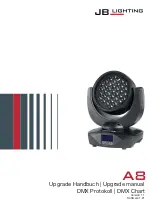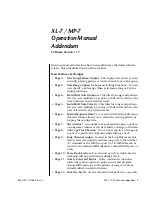
3
General -
1. Check for wear deterioration.
Before each use, carefully inspect your
complete Ultra-Safe system for signs of wear
or deterioration, or evidence of impact loading.
Visually inspect for loose threads, pulled rivets,
burns, cuts, distortions, abrasions, or other
evidence of chemical or physical deterioration
that may have weakened the material or
assembly.
2. Inspect hardware for malfunctions and cracks.
Check all snap hooks, buckles and D-Rings.
3. Destroy and replace all worn
or damaged equipment.
Immediately destroy and replace any component
which does not pass inspection.
Specific -
1. Stitching and webbing.
Check stitching for broken, burned, cut or pulled
stitches. Broken strands of webbing appear as
tufts on the webbing surface. To visually check for
damage caused by corrosives, heat, chemicals
and other conditions, hold the connecting device
with your hands six to eight inches apart. Bend
the webbing in an inverted "U" to cause surface
tension and expose problem areas. Inspect entire
length. For deceleration units, check the stitching
for broken, burned, cut or pulled stitches, and the
breakaway jacket for cuts, tears, broken stitches,
stretch marks or other evidence of impact load.
For aircraft-cable lanyards, check the full length
for breaks, burns or cuts in the vinyl covering and
the aircraft cable.
2. Check for broken strands.
Inspect rope lanyards for broken strands by
twisting the rope slightly to undo the braiding.
Inspect the entire lanyard in this manner.
Lanyards with broken strands must be discarded.
3. Inspect all snap hooks, D-Rings and
other metal parts.
Hardware must be checked for sharp edges and
cracks. Rollers should not be distorted in shape
and should roll freely. Check all parts, especially
corners and attachments points, for wear and
cracks.
4. Destroy and replace all worn or damaged
Ultra-Safe equipment.
If evidence of excessive wear, deterioration or
mechanical malfunction is observed, replace the
equipment immediately.
Never work with worn or
damaged Ultra-Safe equipment. Using damaged
or worn equipment can cause injury or death.
5
. The inspector is the most important part
of any inspection procedure.
Check all equipment thoroughly and follow all
safety procedures and guidelines. Do not take
any shortcuts', they could result in injury or death.
NOTE:
Twisted rope, such as the nylon filament
and polyplus rope used in Ultra-Safe lanyards,
is subject to a condition known as "hockling",
which is similar to the twisting we often see
in a telephone handset cord. This can be
caused by a repetitive twisting movement
such as normal hand rotation in hooking
and unhooking, a lanyard dangling freely,
or by using the lanyard to suspend equipment.
Preventive measures include:
1) Never using a lanyard for towing or hoisting,
2) Inspection and smoothing out after each use,
3) Storing neatly. Some hockling is normal,
and in itself is not cause to discard
the lanyard.
Inspection Procedures
Serial Number:
Model Number:
Date Purchased:
Inspection Date
Inspection Items Noted
Corrective Action
Maintenance Performed
Date of First Use:
INSPECTION AND MAINTENANCE LOG
IMPORTANT NOTE:
OSHA specifies that all employers covered by the Occupational Safety and Health Act are responsible for inspection and
maintenance of all tools and equipment used by employees, whether owned by the employees or by the company. All Ultra-Safe equipment
should be inspected before each use, and immediately removed from service if equipment does not pass inspection.
Approved By:
Approved By:
Approved By:
Approved By:
Approved By:
Approved By:
Approved By:
Approved By:






















